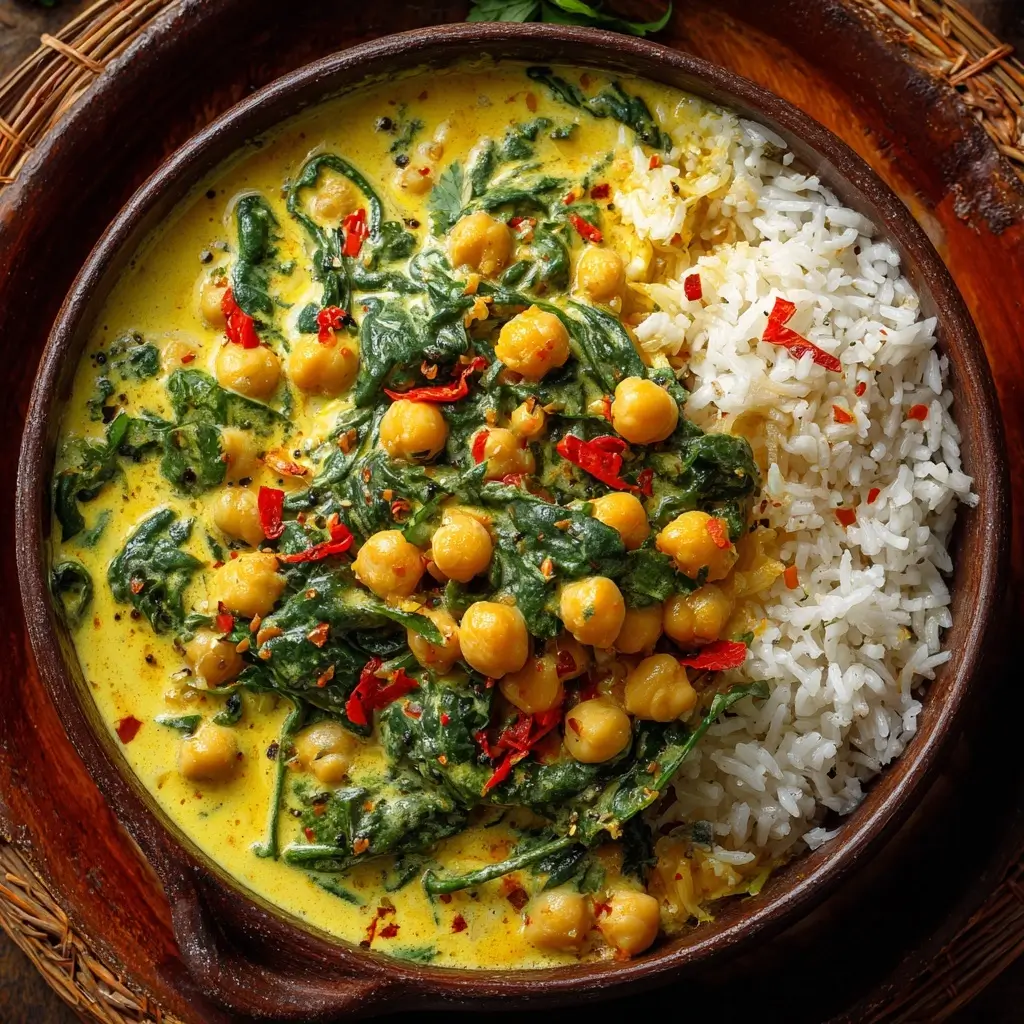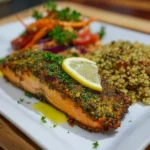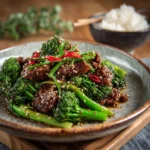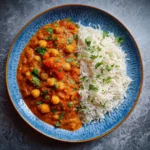Chickpea & Spinach Curry with Coconut Milk: A Flavorful, Nutrient-Packed Delight
If you’re searching for a hearty, wholesome, and deeply satisfying plant-based meal that warms both the body and soul, look no further than Chickpea & Spinach Curry with Coconut Milk. This vibrant dish brings together the earthy richness of chickpeas, the lush greenness of spinach, and the creamy sweetness of coconut milk to create a curry that’s as nutritious as it is delicious. Whether you’re a seasoned vegetarian, an adventurous omnivore, or simply looking to incorporate more plant-powered meals into your diet, this curry will quickly become a staple in your kitchen.
The History of Chickpea & Spinach Curry with Coconut Milk
While the exact origin of this specific recipe isn’t tied to one singular region, its roots lie deep within the culinary traditions of South Asia—particularly India, Sri Lanka, and parts of East Africa where coconut milk and legumes are dietary staples. Chickpeas (also known as garbanzo beans) have been cultivated for over 7,500 years and were first domesticated in the Middle East before spreading across the Mediterranean and Indian subcontinent.
In Indian cuisine, chickpeas are often used in curries such as chana masala, while spinach features prominently in dishes like palak paneer. The fusion of these two ingredients likely evolved from regional home cooking practices where seasonal greens were added to legume-based stews for added nutrition and color. The use of coconut milk, common in coastal regions of India (like Kerala and Goa), Southeast Asia, and East African countries such as Tanzania and Kenya, adds a luscious creaminess that balances out the bold spices.
This particular version—combining chickpeas, spinach, and coconut milk—is emblematic of modern global fusion cooking. It respects traditional techniques while adapting to contemporary tastes and health-conscious lifestyles. Today, it’s beloved not only in homes but also on restaurant menus worldwide as part of the growing popularity of vegan and vegetarian comfort food with international flair.
Ingredients Breakdown: What Makes This Curry So Special?
The magic of Chickpea & Spinach Curry lies in the harmony between its core components. Each ingredient plays a vital role in building flavor, texture, and nutritional value. Let’s dive into what goes into this aromatic masterpiece:
- Chickpeas: Packed with plant-based protein and fiber, chickpeas provide a meaty texture and nutty taste that holds up beautifully in slow-simmered sauces.
- Fresh Spinach: Tender baby spinach wilts perfectly into the curry, adding iron, folate, and a subtle earthy note without overpowering other flavors.
- Coconut Milk: Full-fat canned coconut milk lends a velvety richness and natural sweetness that mellows spicy and tangy elements. Its healthy medium-chain triglycerides (MCTs) make it a favorite in paleo and dairy-free diets.
- Aromatics (Onion, Garlic, Ginger): These form the flavor base of nearly all Indian-inspired curries. Sautéed until golden, they add depth, warmth, and complexity.
- Tomatoes: Fresh or canned diced tomatoes introduce acidity and brightness, helping to balance the richness of the coconut milk.
- Spices: A blend of ground cumin, coriander, turmeric, garam masala, and smoked paprika creates layers of warm, earthy, slightly sweet, and mildly pungent notes. Turmeric also contributes anti-inflammatory benefits.
- Fresh Herbs: Cilantro adds a citrusy freshness at the end, cutting through the creaminess and elevating the overall aroma.
- Olive Oil or Coconut Oil: Used for sautéing, both oils enhance flavor and support the absorption of fat-soluble vitamins from spices like turmeric.
- Lime Juice (optional): A splash just before serving brightens the entire dish and enhances flavor perception.
Together, these ingredients create a symphony of taste and texture—creamy, savory, slightly spicy, and utterly comforting.
Step-by-Step Recipe: How to Make Chickpea & Spinach Curry with Coconut Milk
Follow this detailed guide to prepare a restaurant-quality Chickpea & Spinach Curry right in your own kitchen. This method ensures maximum flavor development and perfect consistency every time.
- Gather Your Ingredients: Before beginning, measure out all ingredients. Mise en place is key to smooth cooking.
- Heat the Oil: In a large, heavy-bottomed pot or Dutch oven, heat 2 tablespoons of olive oil or coconut oil over medium heat.
- Sauté the Aromatics: Add 1 finely chopped onion and cook for 5–7 minutes until soft and translucent. Stir in 4 minced garlic cloves and 1 tablespoon of freshly grated ginger. Cook for another 1–2 minutes until fragrant—do not let them burn.
- Bloom the Spices: Reduce heat to low and add 1 teaspoon ground cumin, 1 teaspoon ground coriander, 1/2 teaspoon turmeric, 1/2 teaspoon smoked paprika, and 1/2 teaspoon garam masala. Stir constantly for about 30 seconds to toast the spices and release their essential oils. This step is crucial—it deepens the flavor profile dramatically.
- Add Tomatoes: Pour in 1 can (14 oz / 400g) of diced tomatoes (with juices). Increase heat to medium and simmer for 5–6 minutes, allowing the mixture to thicken slightly and the raw tomato taste to mellow.
- Incorporate Coconut Milk: Stir in 1 can (13.5–14 oz / 400ml) of full-fat coconut milk. Use light coconut milk if preferred, though the sauce will be thinner and less rich. Mix well to combine with the tomato-spice base.
- Add Chickpeas: Drain and rinse 2 cans (15 oz / 425g each) of chickpeas. Add them to the pot and stir gently. Alternatively, you can use 1 cup of dried chickpeas soaked overnight and cooked until tender (yields about 2.5 cups).
- Simmer Gently: Bring the mixture to a gentle simmer. Do not boil vigorously, as coconut milk may separate. Let it cook uncovered for 15–20 minutes, stirring occasionally, to allow flavors to meld and the sauce to thicken.
- Wilt in the Spinach: Gradually add 4–6 cups of fresh baby spinach (or 1 package frozen chopped spinach, thawed and drained). Stir until completely wilted—this takes just 2–3 minutes. For deeper flavor, you can substitute half the spinach with chopped kale or Swiss chard.
- Season to Taste: Add salt (start with 1 tsp) and freshly ground black pepper. Adjust spice levels with red chili flakes or cayenne if desired. A squeeze of fresh lime juice (about 1 tablespoon) enhances the overall brightness.
- Finish with Fresh Cilantro: Stir in a handful of chopped fresh cilantro just before serving.
- Rest Before Serving: Turn off the heat and let the curry sit for 5–10 minutes. This resting period allows the flavors to deepen further.
Serve hot alongside basmati rice, quinoa, naan bread, or roasted sweet potatoes for a complete meal.
Tips for the Perfect Chickpea & Spinach Curry
- Use Full-Fat Coconut Milk: It provides the richest texture and best mouthfeel. Shake the can well before opening, or blend it briefly if separation occurs.
- Toast Spices Carefully: Blooming spices in oil unlocks their full potential, but watch closely—burnt spices turn bitter instantly.
- Don’t Rush the Onions: Cooking onions slowly develops sweetness and prevents sharpness in the final dish.
- Adjust Consistency: If the curry is too thick, add a splash of vegetable broth or water. If too thin, simmer longer or mash a few chickpeas to thicken the sauce naturally.
- Add Acid at the End: Lime or lemon juice should be added just before serving to preserve its zesty punch.
- Make Ahead Magic: Curries often taste better the next day! Store in the fridge for up to 4 days and reheat gently on the stove.
- Freeze for Later: This curry freezes exceptionally well for up to 3 months. Cool completely, then store in airtight containers or freezer bags.
- Boost Umami: For extra depth, consider adding 1 teaspoon of soy sauce, tamari, or a small piece of kombu seaweed during simmering (remove before serving).
Variations and Customizations
One of the greatest strengths of this recipe is its versatility. Feel free to tailor it to your preferences, dietary needs, or what you have on hand:
- Protein Boost: Add cubed tofu, tempeh, cooked lentils, or even shredded chicken for a non-vegetarian twist.
- Vegetable Add-Ins: Enhance nutrition and texture by including diced bell peppers, zucchini, cauliflower florets, carrots, or sweet potatoes. Sauté them with the onions or add later depending on cooking time needed.
- Greens Swap: Replace spinach with kale, collard greens, mustard greens, or Swiss chard. Just increase cooking time slightly for tougher greens.
- Spice Level Control: Mild? Skip chilies. Hotter? Add fresh green chilies, serrano peppers, or a dash of hot sauce like sriracha.
- Creaminess Alternatives: No coconut milk? Try cashew cream (blend soaked cashews with water), almond milk (thicker versions), or even Greek yogurt stirred in at the end (not vegan).
- Curry Style Twists:
- Thai-Inspired: Use red curry paste instead of dry spices, add bamboo shoots and bell peppers, finish with basil.
- Caribbean Flair: Add allspice, thyme, scotch bonnet pepper, and serve with rice and peas.
- Middle Eastern Touch: Include za’atar, sumac, and top with tahini drizzle and pomegranate seeds.
- Gluten-Free Option: Naturally gluten-free, provided all packaged ingredients (like broth or canned goods) are certified GF.
- Oil-Free Version: Sauté aromatics in water or vegetable broth to make this oil-free and suitable for whole-food, plant-based diets.
Health Considerations and Nutritional Value
Chickpea & Spinach Curry with Coconut Milk isn’t just flavorful—it’s a powerhouse of nutrients that supports long-term health and wellness.
Nutritional Highlights (per serving, approx. 1.5 cups):
- Calories: ~320–380 kcal (depends on coconut milk and oil used)
- Protein: 12–15g – excellent plant-based source from chickpeas
- Fiber: 10–12g – promotes digestive health and satiety
- Healthy Fats: Medium-chain fatty acids from coconut milk; monounsaturated fats from olive oil
- Iron: High from spinach and chickpeas—pair with vitamin C (like tomatoes or lime juice) for better absorption
- Folate: Crucial for cell function and especially important during pregnancy
- Vitamin K: Abundant in leafy greens, supporting bone and heart health
- Antioxidants: From turmeric (curcumin), tomatoes (lycopene), and garlic (allicin)—linked to reduced inflammation and chronic disease risk
Health Benefits:
- Supports Heart Health: Fiber, unsaturated fats, and potassium help regulate blood pressure and cholesterol.
- Promotes Gut Health: High fiber content feeds beneficial gut bacteria.
- Anti-Inflammatory Properties: Thanks to turmeric, ginger, garlic, and omega-3s in spinach.
- Blood Sugar Regulation: Low glycemic index due to complex carbs and high fiber—ideal for diabetics when portion-controlled.
- Weight Management Friendly: High volume, nutrient-dense, and filling without being overly caloric.
Dietary Notes:
- Vegan & Vegetarian: Yes, naturally
- Dairy-Free: Yes (ensure no butter or yogurt is added)
- Gluten-Free: Yes, when using gluten-free-certified ingredients
- Allergen Alert: Contains coconut (a tree nut); omit or substitute if allergic.
- Portion Awareness: Coconut milk is calorie-dense. For lower-calorie versions, use light coconut milk or dilute with broth.
Ingredients
- 2 tablespoons olive oil or coconut oil
- 1 large yellow onion, finely chopped
- 4 garlic cloves, minced
- 1 tablespoon fresh ginger, grated
- 1 teaspoon ground cumin
- 1 teaspoon ground coriander
- 1/2 teaspoon ground turmeric
- 1/2 teaspoon smoked paprika
- 1/2 teaspoon garam masala (plus more for garnish)
- 1/4 teaspoon red chili flakes (optional, adjust to taste)
- 1 can (14 oz / 400g) diced tomatoes (with juice)
- 1 can (13.5–14 oz / 400ml) full-fat coconut milk
- 2 cans (15 oz / 425g each) chickpeas, drained and rinsed
- 4–6 cups fresh baby spinach (about 6 oz / 170g)
- 1 tsp salt (or to taste)
- Freshly ground black pepper, to taste
- 1 tablespoon fresh lime juice (from about 1/2 lime)
- 1/3 cup fresh cilantro, chopped (plus extra for garnish)
Directions
- Heat oil in a large pot or Dutch oven over medium heat.
- Add chopped onion and sauté for 5–7 minutes until soft and translucent.
- Stir in minced garlic and grated ginger; cook for 1–2 minutes until fragrant.
- Reduce heat to low. Add cumin, coriander, turmeric, smoked paprika, garam masala, and chili flakes. Stir constantly for 30 seconds to toast the spices.
- Pour in diced tomatoes with their juices. Simmer for 5–6 minutes, stirring occasionally, until the mixture thickens slightly.
- Stir in coconut milk until fully combined.
- Add drained chickpeas and mix gently. Bring to a gentle simmer (do not boil hard).
- Simmer uncovered for 15–20 minutes, stirring occasionally, to develop flavors and thicken the sauce.
- Gradually add spinach, a handful at a time, stirring until fully wilted (about 2–3 minutes).
- Season with salt, black pepper, and lime juice. Taste and adjust seasoning as needed.
- Remove from heat. Stir in chopped cilantro.
- Let stand for 5–10 minutes before serving to allow flavors to settle.
- Serve warm with rice, quinoa, or naan. Garnish with extra cilantro and a sprinkle of garam masala if desired.
FAQ
Can I use frozen spinach instead of fresh?
Yes! Use about 10 oz (280g) of frozen chopped spinach, thawed and squeezed dry. Add it at the same point as fresh spinach.
Is this curry spicy?
Not inherently. The base recipe is mildly spiced. You can control the heat level by adjusting chili flakes, adding fresh chilies, or increasing black pepper.
Can I make this in a slow cooker or Instant Pot?
Absolutely! For a slow cooker: sauté aromatics and spices first, then transfer to the crockpot with remaining ingredients (except spinach and cilantro). Cook on low for 6–7 hours or high for 3–4. Stir in spinach and cilantro at the end.
For Instant Pot: use Sauté function for onions, garlic, ginger, and spices. Add tomatoes, coconut milk, and chickpeas. Pressure cook on High for 5 minutes, quick release. Stir in spinach until wilted.
Why did my coconut milk separate?
Coconut milk can split if boiled too vigorously or exposed to sudden temperature changes. To prevent this, keep the heat at a gentle simmer and avoid boiling after adding coconut milk.
How do I make this nut-free?
Since coconut is classified as a tree nut by the FDA, those with nut allergies should avoid it. Substitute with cashew-free cream alternatives like oat milk blended with sunflower seeds or a commercial nut-free creamer.
What can I serve with this curry?
Excellent pairings include:
- Basmati or jasmine rice
- Quinoa or millet
- Naan, roti, or chapati
- Raita (yogurt sauce with cucumber and mint)
- Pickled onions or mango chutney
- Roasted vegetables or salad
Can I double the recipe?
Yes! This recipe scales well. Use a very large pot or divide between two pots to ensure even cooking. Double-check spice quantities to maintain balance.
Summary
Chickpea & Spinach Curry with Coconut Milk is a nourishing, aromatic dish that combines protein-rich legumes, leafy greens, and creamy coconut in a warmly spiced sauce. Easy to customize and perfect for meal prep, it’s a wholesome meal that satisfies both palate and body.










